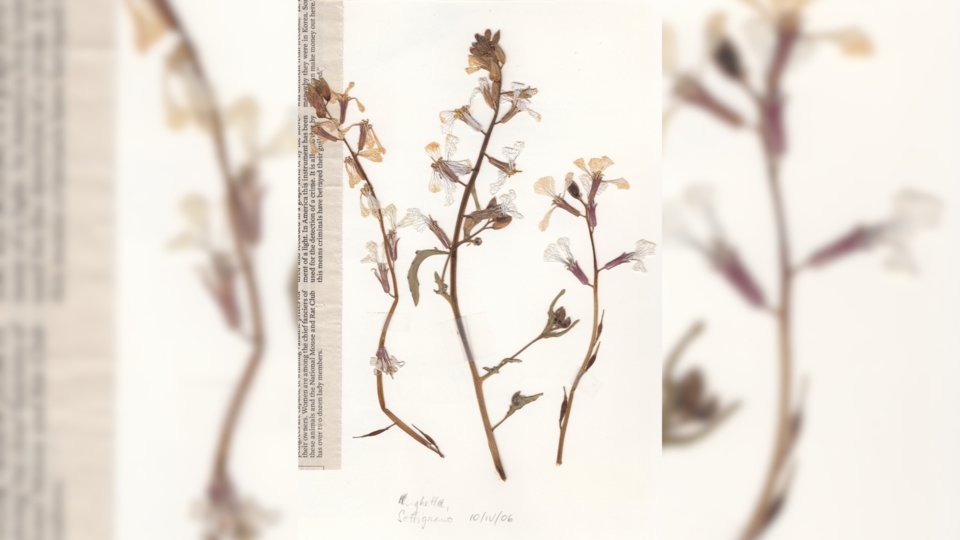By now we have many ways to turn living flora into virtual reality, but there’s an ancient craft that surpasses any of them. While the techniques of 3D models, Dall-E 2, Autodraw, among others, can replicate plants, pressing real specimens produces inimitable results, especially in the way they’re laid out and in the preservation of their very subtle texture. It’s a reality that can stay real for centuries.
In the last 500 years of collecting and pressing live plants, two individuals, both Italian, stand out at the beginning of this history – Luca Ghini (1490 to 1556), physician and botanist, and his student, Gherardo Cibo (1512 to 1600), artist and botanist. Specimens that Cibo gathered and pressed (hortus siccus, Latin for dry garden, is an early name for pressed plants) survive in the Biblioteca Angelica in Rome. His paintings of plants, with backgrounds showing plant collectors digging up the samples, are contained in two manuscripts in the British Library, London.
Nowadays we refer to a collection of dried plants as a herbarium (plural herbaria), a term first used in this sense by the French botanist Joseph Pitton de Tournefort (1656 to 1708). Herbarium also refers to the museum in which such collections are preserved. The University of British Columbia’s herbarium, part of the Beaty Biodiversity Museum, is the largest in western Canada.
In the 19th century, pressing plants became a popular pastime for Victorian ladies. They would arrange the dried plants in artful compositions, a technique believed to have been inspired by oshibana, the Japanese art of creating pictures with pressed flowers.
Collecting and pressing plants is something anyone can do. And it needn’t cost a penny. The simplest method of drying and pressing requires no more equipment than paper and a weight. Telephone directories, which are still given out free, are ideal. Carefully lay the plants between the pages and weigh down the directory with something heavy, such as bricks or several thick books. The plants should be dried and pressed within two weeks. Of course, it’s better to leave them for longer if you have sufficient patience.
Are you longing for a proper plant press but don’t want to buy one? You can make it at home, using just a few basic tools. This video shows how to make a press very similar to the one my father made for me.
When using a press, you lay the plants between sheets of heavy paper (blotting paper is ideal), layered with pieces of corrugated cardboard. Although you’re advised to change the paper every few days, I never did, and my plants dried perfectly. It’s a good idea to make a note of the identity of the plant you’re pressing, as well as the date you collected it, and when it’s a wild plant, also the place where you found it.
There are several recently published books with information about plant pressing, although Richmond Public Library has only one – Helen Humphreys, Field Study. Meditations on a Year at the Herbarium, 2021. I’ve requested that the library order a copy of Pressed Plants: Making a Herbarium, 2023, by Linda P.J. Lipsen, Collections Curator of Vascular Plants & Algae at the Herbarium, Beaty Biodiversity Museum, UBC.
If you’re drying plants for craft projects rather than scientific study, give free rein to your imagination. In addition to pictures, you can make cards, for instance. You can decorate furniture – years ago a friend laid dried red leaves on top of a side table, covering it with a thick piece of glass. It was stunning. In my home in Florence, I arranged leaves between two sheets of glass, which I hung in a window – the effect of daylight streaming through was reminiscent of a stained glass window.
Recently the New York Times garden columnist, Margaret Roach, wrote a piece that begins with a memory of her grandmother, from whom she’d inherited a love of plants and gardens. What sparked the memory were two “pressed-flower pictures” with which, she felt, her grandmother had “wanted to pass along the spirit of the garden.”
In her column, entitled Why Are People Still Pressing Flowers? It’s a Form of Storytelling, Roach argues persuasively that we can derive singular pleasure from this ancient tradition. But the satisfaction provided by collecting and pressing plants goes even further. It’s also a way of bringing us in closer touch with the flora around us. It’s a way to make us see plants as more than part of the generic landscape. It’s a way to increase our awareness. And increased awareness helps us recognize that the conservation of our environment is essential.
Sabine Eiche is a local writer and art historian with a PhD from Princeton University. She is passionately involved in preserving the environment and protecting nature. Her columns deal with a broad range of topics and often include the history (etymology) of words in order to shed extra light on the subject.



